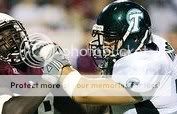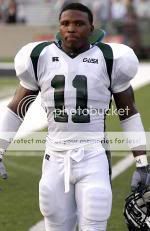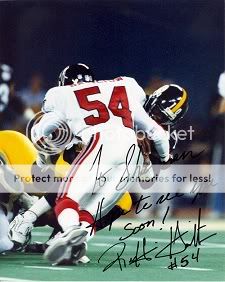Top 25 Players: #15-#14
Today’s additions bring out the question of how to appraise the odd evolutions in traditional positions in C-USA? For example, C-USA offensive linemen have long ago separated from the SEC/NFL prototype. If the League generates surplus distribution quarterbacks and smaller speedy guys, it has never squared the circle on how to generate productive linemen en masse.
Thus, the League exists to de-emphasize the offensive line. The spread offenses are predicated on getting the ball out of the quarterback’s hands quickly and getting defenders out of the box so you can run the football against fewer defenders. The motivation for these adjustments is partly an inability to find people who can block: pass protect, win the battles in the tackle box in the running game.
So, when a quality offensive lineman does surface, he is often hobbled because although he can block his assignments, others cannot. So the low demand offensive approach continues unabated. C-USA exists to hide offensive linemen- it is hard to shine.
But first- another category of player hard to rate- the fullback. As a skill player, they do generate some numbers, but they aren’t the primary offensive skill assets. Much like the tight end, they make a mark blocking and doing a little of everything: catch a pass here, get a tough yard there...
15. Jerald Sowell, FB (1993-1996)
 So, speaking of tough, Jerald Sowell is another player who dates back to the regional independent days- back when Tulane ran a pro-style offense with actual blockers. Okay, they ran it badly. Some guy named Craig Randall was the quarterback. We all pretended Jamaican Dartez was pretty okay.
So, speaking of tough, Jerald Sowell is another player who dates back to the regional independent days- back when Tulane ran a pro-style offense with actual blockers. Okay, they ran it badly. Some guy named Craig Randall was the quarterback. We all pretended Jamaican Dartez was pretty okay.But Jerald Sowell was the real deal- the best fullback of an era that had some real good ones at Tulane. He succeeded the quality Chance Miller- and a few years later was followed by the challenging Tony Converse.
Buddy Teevens believed in using the fullback. Coupled with the fact the tailback position was a black hole sucking in all sorts of terrible in that era, Jerald Sowell put up good numbers as an ancillary option: ninth all-time in carries, eleventh in rushing yards, caught thirty balls one year. And he was real good from day one- led the team in rushing three times in his career, including as a freshman.
In addition, he put his numbers up against real teams, in an era where a 100-yard rushing day was an accomplishment. He has 100-yard rushing days versus LSU, Alabama and Southern Mississippi- and holds the school record for longest play from scrimmage (98-yard run versus the Crimson Tide).
Plus, he was an outstanding fullback- crushing blocker, possession receiver, an NFL prospect from the first day he lined up. I can’t think of any other Tulane player who was a legitimite NFL prospect for all four years he played. He played ten NFL seasons- mostly with the Jets.
14. Troy Kropog, OT (2005-2008)
 Like a lot of Tulane fans, I tuned into the nationally televised 2007 Tulane-LSU tilt. Most fans spent the game heartened by a spirited showing. I spent the game wondering just who in hell was playing left tackle for Tulane, poking the Chi O every time Kropog blew up another LSU lineman.
Like a lot of Tulane fans, I tuned into the nationally televised 2007 Tulane-LSU tilt. Most fans spent the game heartened by a spirited showing. I spent the game wondering just who in hell was playing left tackle for Tulane, poking the Chi O every time Kropog blew up another LSU lineman.Troy Kropog became a top NFL prospect that day. It was a remarkable journey of the most improved player, from day one to finish, that I can recall.
We’d seen the Kropog-type a zillion times in C-USA. Well undersized, but he was pretty athletic (a 250-pound kid can play well in the trenches in high school)- he was still a true stab in the dark, groping for some serviceable upside, a depth player. There was some vague tight end talk (he was slight on that enormous frame)- and then he disappeared wherever I-A teams “grow” folks for a red-shirt year, then two years of spot duty. But the utter paucity of offensive lineman in C-USA means real prospects usually are on the field quickly- not a two-plus year journey. He was just a “guy”.
Well, Kropog exploded. He gained sixty pounds, kept the height and athleticism. Turned out he was wicked strong with that extra bulk. And he became the NFL’s holy grail- an athletic, left tackle and top fifty prospect.
He dominated C-USA opposition- first team all C-USA in 2008. He was criminally left off in 2007, named honorable mention, largely due to reputation- but there were absolutely not six League tackles better than him. He would have been a multiple year starter at USC for crying out loud.
 He was the best pass protector ever at Tulane, could get the edge and physically dominated the pass rushers he routinely caught. That same athleticism made him a real weapon on the stretch and draw running plays Tulane liked to run with Forte and Anderson. He could get to the point of attack anywhere- in fact, he created the point of attack because he could run to any spot to do damage. Forget second level, he made blocks on hapless safeties.
He was the best pass protector ever at Tulane, could get the edge and physically dominated the pass rushers he routinely caught. That same athleticism made him a real weapon on the stretch and draw running plays Tulane liked to run with Forte and Anderson. He could get to the point of attack anywhere- in fact, he created the point of attack because he could run to any spot to do damage. Forget second level, he made blocks on hapless safeties.He dropped out of the top fifty close to the draft: shoulder injury questions, a rich tackle draft, some thought he projected better as an OG (which will take you out of the first two rounds in a hurry). He went fourth round to the Titans. But he is a real NFL player. He played this year as the Titan’s third OT- and figures to get every chance to crack the regular rotation this year with the new regime (and there is still some thought to move him to guard to just get him on the field). If you had to pick a Tulane guy who will be in the League in 2018, Kropog is it.
Labels: Tulane Top 25 Players










